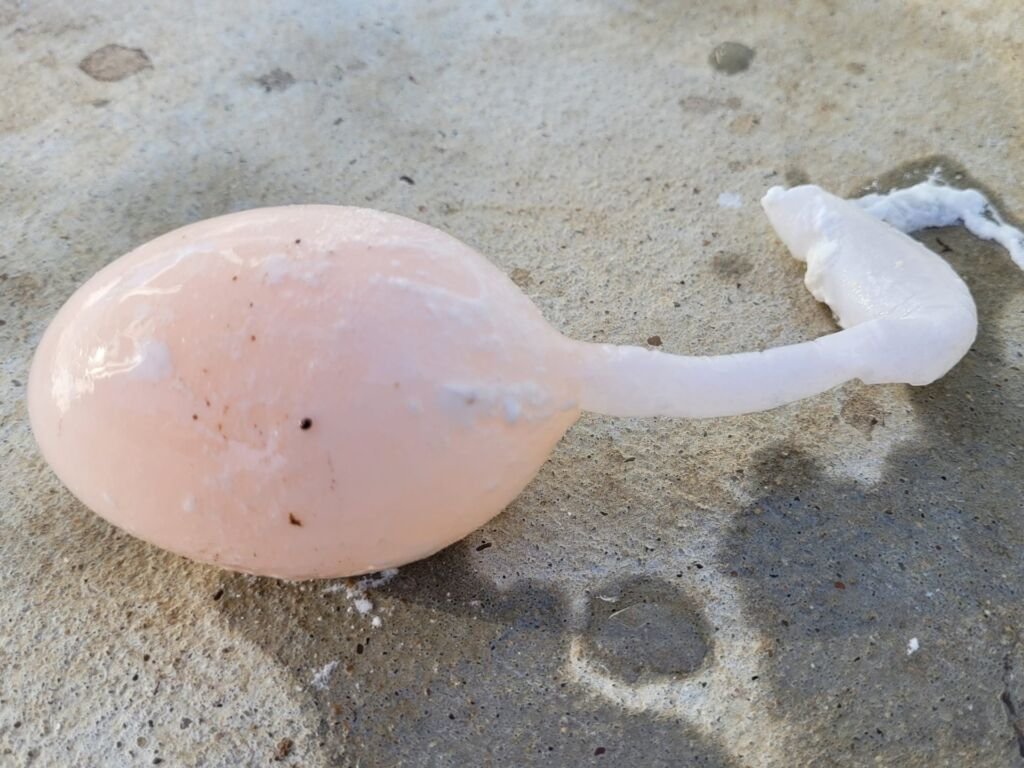Last updated on July 16th, 2024 at 06:31 pm
How do you protect your ducks from predators? With a secure enclosure, of course! First, you should know what predators are in your area. Learn more about common predators. Once you know that, you can start thinking about the type of coop or run that best keeps your ducks safe from these predators. You should do this before getting ducks.
But remember, no matter how much effort you put into the enclosure’s design, nothing will be 100% predator-proof. However, we can make it as safe as possible.
We had a bobcat attack once, and we were lucky that the run was safe and sturdy enough for our ducks to be unharmed.
Disclaimer: I may earn a commission if you purchase products or services through my affiliate links. This does not affect the price you pay, and it helps me to continue creating content for you. I only recommend products and services that I believe in and that I think will be helpful to my readers.
What is the difference between the coop and run?
The coop is usually the actual building your ducks sleep in at night. We also call it our duck house. The run or pen is the enclosure that is a fenced area to keep your ducks protected during the day. The coop is usually inside the run or directly connected to it.
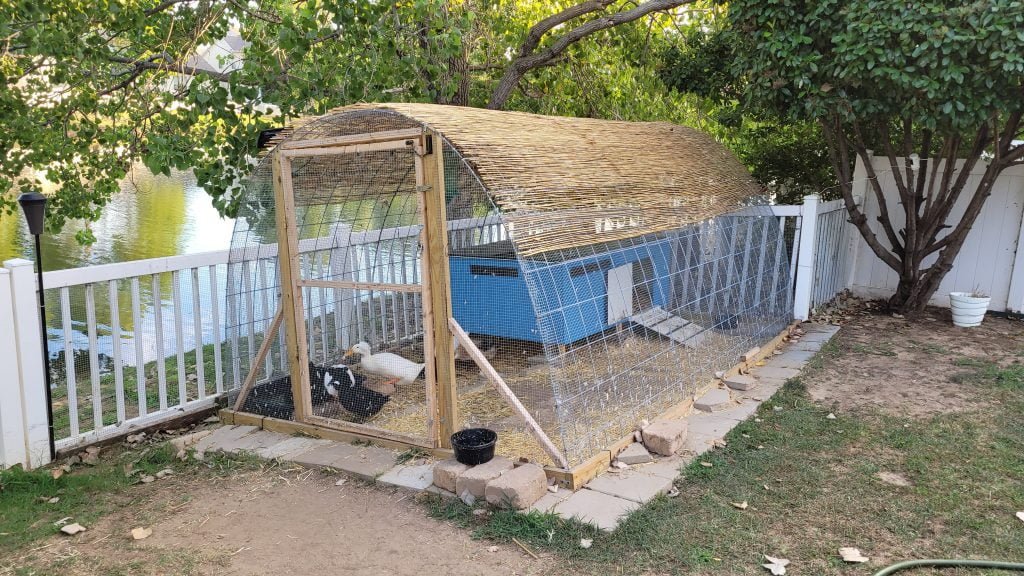
Size matters
Before planning and designing your actual duck home, you should know how many ducks you plan to get. Also, their breeds and genders are important to consider. Larger breeds may need more space than bantam breeds. If you have multiple drakes, you may need to be able to separate them from each other during mating season. Also, consider that you’re very likely to get more ducks (ducks are a gateway drug to more ducks), so starting with a larger coop gives you room to expand your flock. Yes, this is a thing! We started with three and are at seven now. We already needed to expand our coop and run.
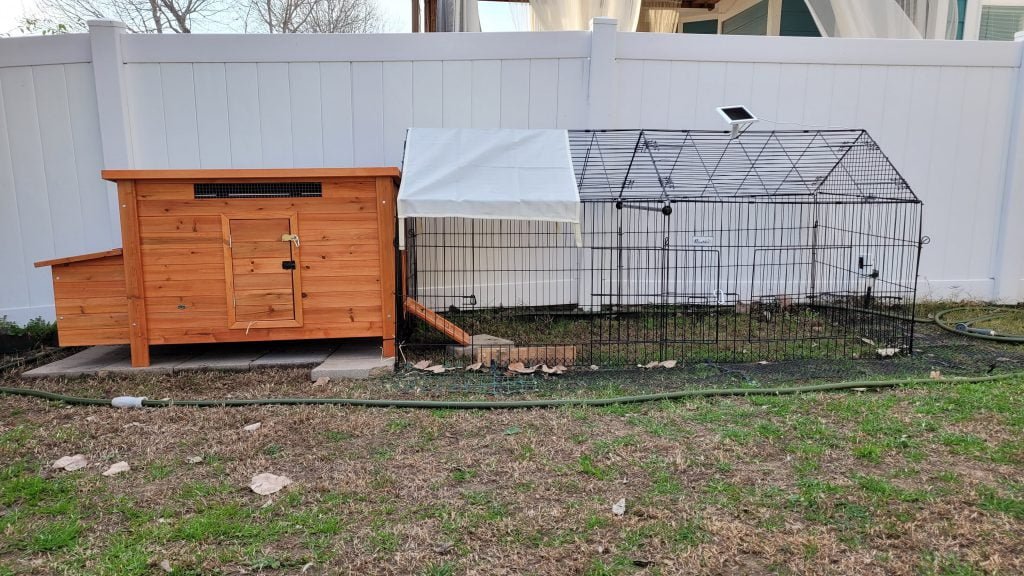
How many square feet per duck should a duck coop be?
You should allow for 4 to 6 square feet of floor space per duck but should be at least 24 square feet even if you have less than six ducks. Since ducks typically sleep on piles of bedding on the floor, they need enough room to be comfortable.
How big should a duck run be?
A rule of thumb is about 16 square feet of floor space per duck, but at least 100 square feet. They need some room to roam around but also a place for their water. A small tub or kiddie pool will be fine. When your ducks are in this run all the time and are not allowed to free range in the yard, you should make it bigger.

Building Materials for a Predator-Safe Enclosure
Generally, the coop and run should be constructed of sturdy materials to withstand larger predators such as coyotes or bobcats and be robust against severe weather.
Here is a link to our Amazon Storefront, which contains many useful materials and even complete coops and runs if you don’t want to build them yourself.
What are suitable framing materials for the coop and run?
Framing material can be either wood or metal. When choosing wood, make sure the material is weather-resistant. Pressure-treated 2x4s are ideal for the frame of your run and coop. You can also use smaller lumber for doors or the roof frame, such as 1×2’s.
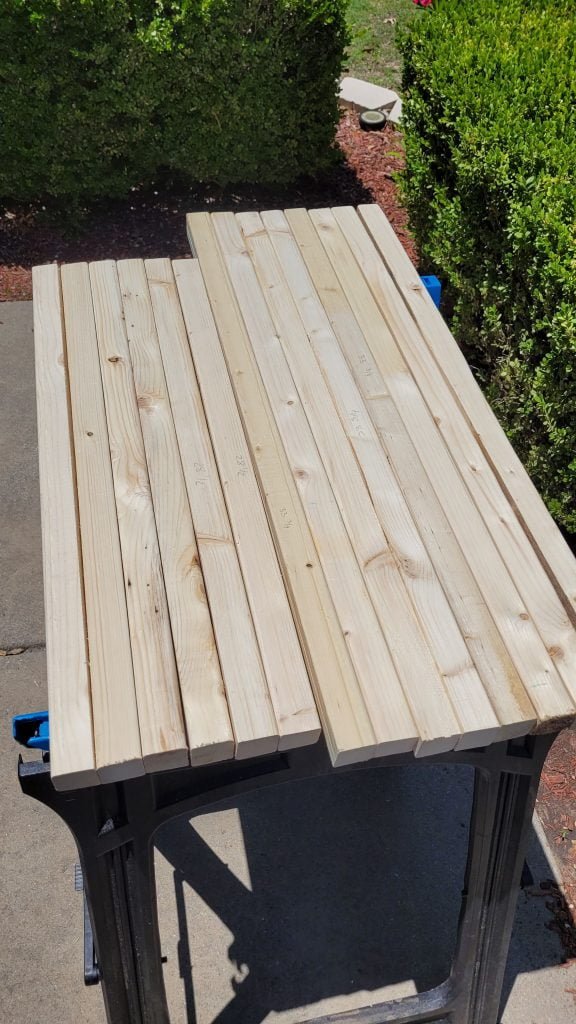

There are also metal posts that you can use. To make it super easy, you can purchase ready-to-assemble walk-in runs for your ducks, like the one below. They come with a galvanized pipe steel frame, a lockable door, and often with a cover. They come in a lot of different sizes. But you need to assemble them yourself, which can be a bit of work and needs more than one person. The disadvantage of these is that they usually come with chicken wire for the sides, but hardware cloth would be better.
When it comes to the coop (the house for the night), they are best made entirely of wood. Use wood panels or OSB panels for the sides, the bottom, and the roof. This gives extra protection from the elements and predators. Make sure that you have enough ventilation for your ducks. Ducks produce a lot of moisture and, therefore, need good ventilation. The opening for ventilation should be covered with hardware cloth for protection against small predators like weasels or snakes. The door should be closable and have a latch or lock. Often, the door is used as the ramp when open.

You can also purchase a coop at local farm stores or online. Since there are not too many coops specifically for ducks available, you should look for chicken coops instead. Just ensure they are not too high because ducks do not like long and steep ramps.
Unlike chickens, ducks do not need to perch, so there is no need to install anything. If the coop comes with nesting boxes, don’t install them. Ducks will also use the nesting boxes when they are at ground level.
What material Should be used for openings and sides?
Hardware cloth is the material of choice. Chicken wire may keep your ducks inside but is not strong enough to keep predators out. Even raccoons can rip it apart. They may also be able to reach through the mesh and injure your ducks.
Poultry DVM also has a great article on tips for protecting chickens and ducks from predators.
You can use chicken wire or wire mesh when you plan to cover these parts of your run with a tarp. This will then give the extra layer of protection. Chicken wire alone will not be sufficient, though. In our case, we have hardware cloth at the bottom, around 5 feet high, and chicken wire on the roof. The chicken wire is covered with a bamboo mat and a tarp during winter.

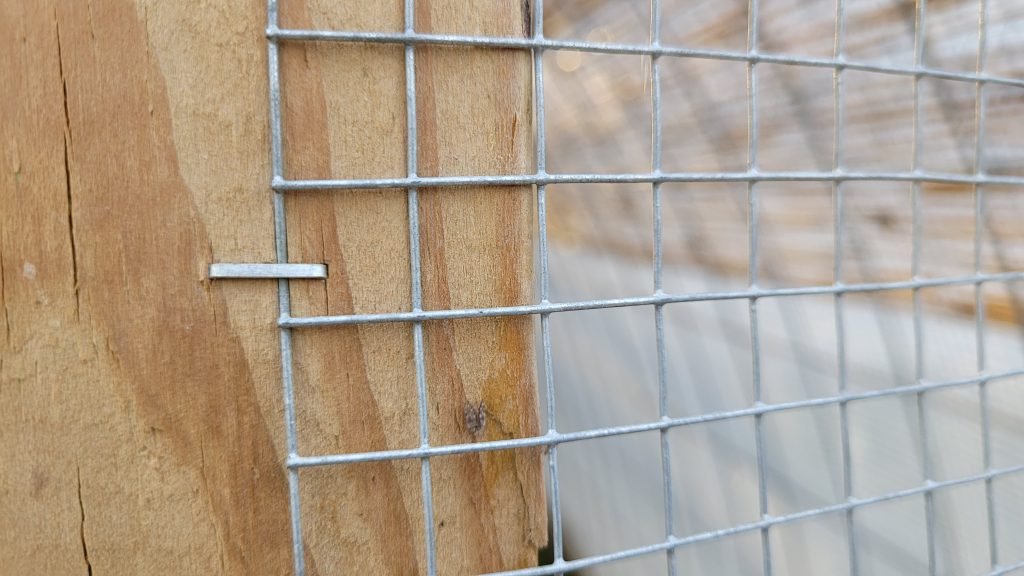
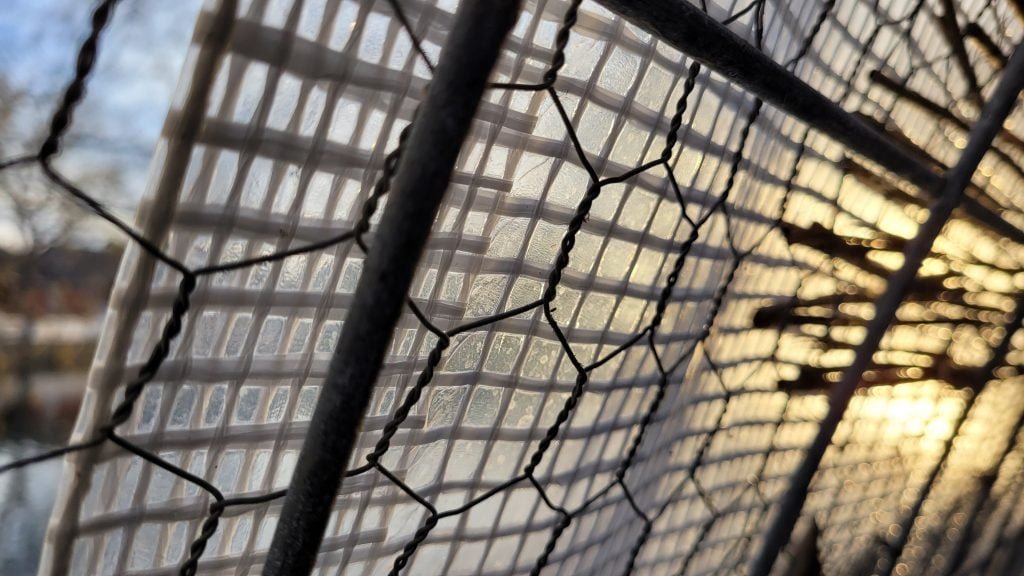


The hardware cloth should be 1/2-inch and galvanized. It is strong enough to withstand most small—to mid-sized predators. The mesh size is fine enough that they can not reach in with their paws to injure your ducks. It is also small enough that smaller predators like weasels or snakes can’t sneak through. The 1/4-inch hardware cloth is often not strong enough because the wires used to make it are thinner.
The hardware cloth should be tightly attached to the wood frame without leaving any bigger gaps. We used a staple gun to attach the hardware cloth to the wood frame, but U-shaped nails will also work.
Do I need a cover?
Yes, the ducks need to be protected from the top as well. Birds of prey could otherwise easily scoop your ducks. Other predators that are good at climbing, such as raccoons, bobcats, or even cougars, could also quickly get into the run if there was no cover on the top. Some predators, like foxes, also jump relatively high. A robust Avian netting might be okay if you are only concerned about hawks or something similar. But in most cases, you will have other predators as well.
You should cover the top with hardware cloth or a sturdy closed roof like vinyl roofing sheets. When using the hardware cloth, you can cover it with a tarp to keep the rain and sun out of your run.
Adding a closed roof to your run will protect your ducks from rain, snow, hail, and other weather. In the summer, it will provide shade. Your ducks probably don’t mind the rain, but without a rain cover, the run will become muddy and slippery in no time.
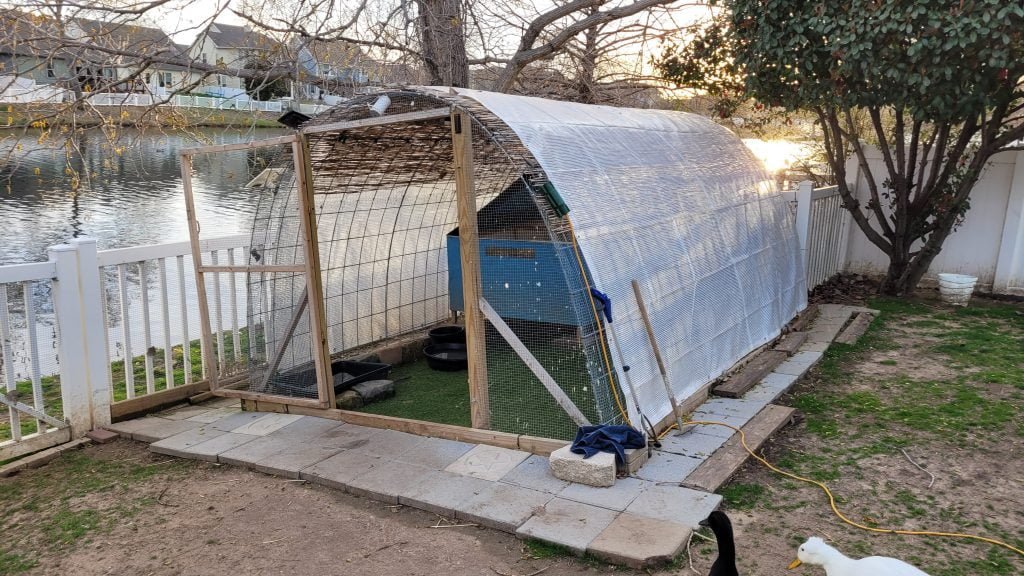

For our current run, we have two versions: a tarp that fully covers the hoop during the winter and a bamboo roof for more shade in the summer.
We love the clear-ish tarp because it is firm and allows light to come through. This heavy-duty tarp also has grommets along the sides for easy fixation. We attach it to the hardware cloth with zip ties.
How do I keep things from digging under and into my duck run?
There are several possibilities. You could have a concrete floor or a wooden deck underneath your run. Concrete, however, is not recommended because ducks should not lie on hard surfaces. This could lead to a condition called bumblefoot.
Many people install a skirt or apron around the coop. This skirt is also made of hardware cloth and extends from the sides into the ground. It should be about two feet long and be slightly buried around the coop. The skirt prevents predators from digging into the run; once they hit the hardware cloth barrier a few times, they’ll give up and move on.
We could not realize that in our yard because of the location of our hoop coop. It is too close to the fence, and the irrigation system pipes and fiber optic cables also run underneath. This is why we have a two-foot wide skirt of pavers around the coop. We also have artificial turf in our run. This extends about 1 foot beyond the run at all sides and prevents anything from digging inside.
What type of door latches should be used?
You should use secure 2-step locks or carabiners on the duck house – coop or run that will prevent the entry door from being opened or loosened by inclement weather or predators. Some predators, like raccoons, are smart and handy enough to open simple 1-step latch locks to get inside coops to eat eggs and even young birds.
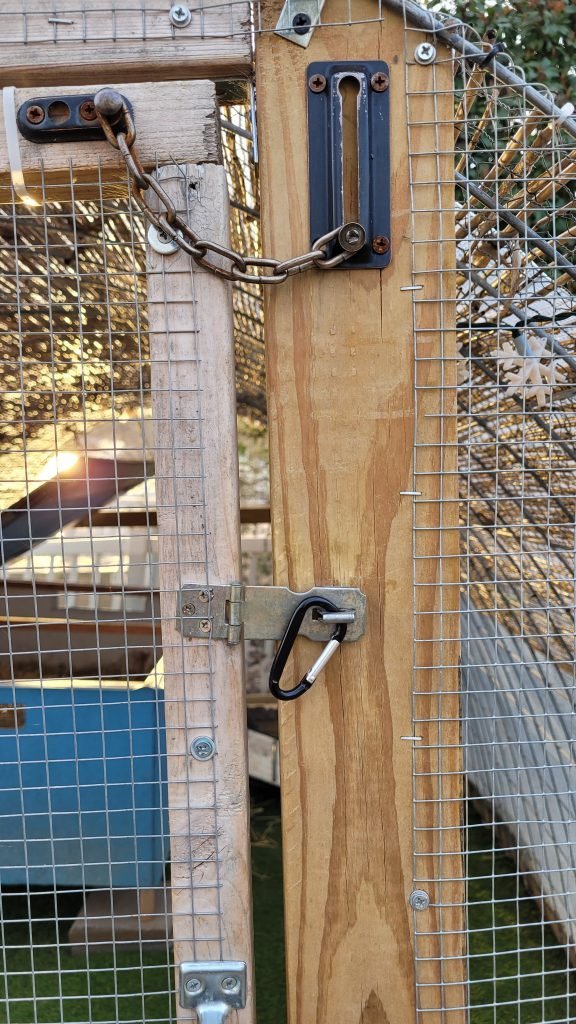
What are suitable flooring materials for the coop and run?
For the coop, the best bedding includes straw, pine shavings, or hemp bedding. Everything that dries quickly and does not start to mold. Hay might, therefore, not be the best choice.
Ducks love to build nests for their eggs. But they also want to have it warm in the winter. Having a bedding material that isolates is ideal. While ducks are generally quite hardy and can withstand cold weather, you want to ensure their feet are warm and protected from ice to prevent frostbite. And who doesn’t like a warm and cozy bed anyway? We use mainly straw in their coop. And it is always so much fun to see how happy the ducks are when they get fresh straw. They immediately start digging and foraging.
We prefer pine shavings for the brooder and the playpen inside the house. It is a bit easier to clean for smaller pens, at least in my opinion. Please make sure that you are not using cedar bedding. This is unhealthy for ducks.
Hemp bedding is also great. It smells nice and is not as dusty as the other bedding. However, it is more expensive, so we only use it sometimes.
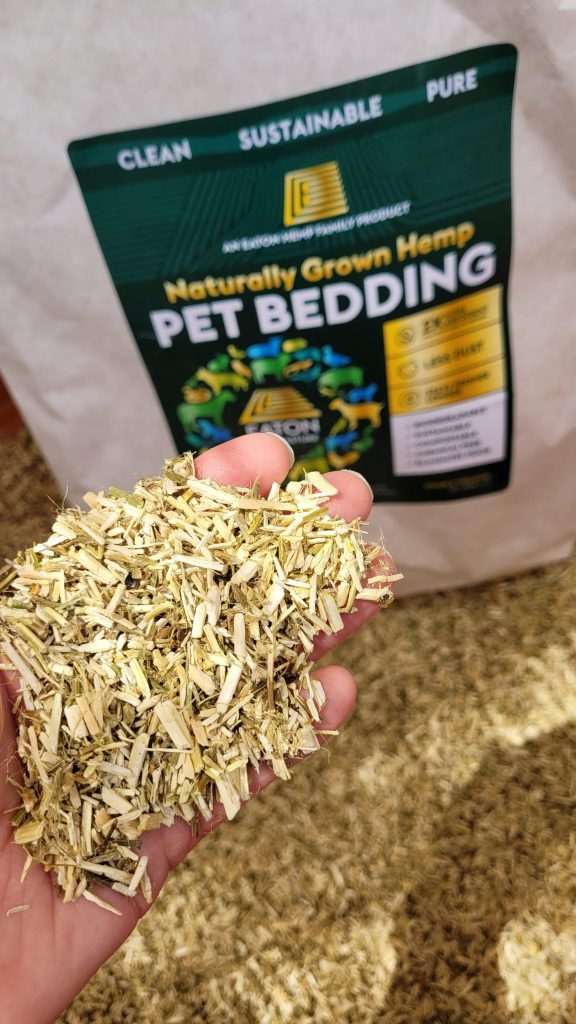

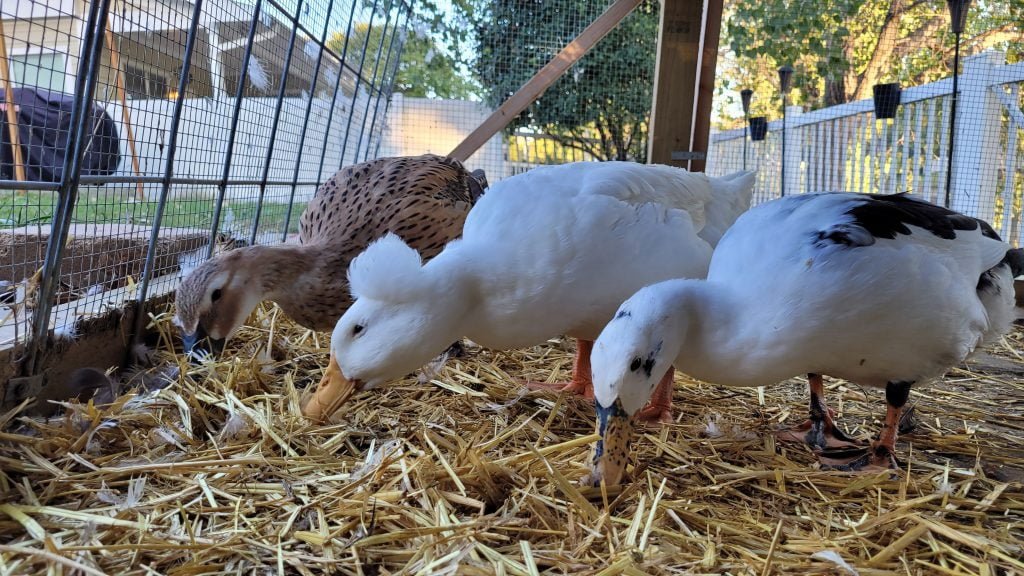
The run can be either just the natural ground, which means soil or grass. With ducks, however, that won’t last long and will soon turn into a muddy hell. Some people use pea gravel as ground cover. This enables easy drainage. And since the pebbles are rounded, they do not have sharp edges that could injure your duck’s feet. It is probably best used around their water sources, such as water bows or small pools, to prevent mud. We used it for a while, and it was great regarding mud prevention. However, we think it may have caused bumblefoot in some of our ducks. So, if you use it, make sure to have areas in the run with a softer ground cover that is easier on the duck feet.

We have recently changed to artificial turf. We are happy with it so far. It is very easy to clean – just hose it down, and all duck poop is gone in no time without any mud. It is also soft on their feet. The only downsides are that 1) it might get hot in the summer, and 2) the ducks are disappointed because they can not make a mess anymore. But they are still trying, though.


What else might be helpful?
Cameras
Security cameras are also a good idea. That way, you can continually monitor what’s going on in your run or coop. We have several cameras, one in the yard, that oversee the coop and allow us to see if a predator is snooping around the coop. We also have one inside the run to see what is going on inside and one inside the coop to see what they are doing during the night.
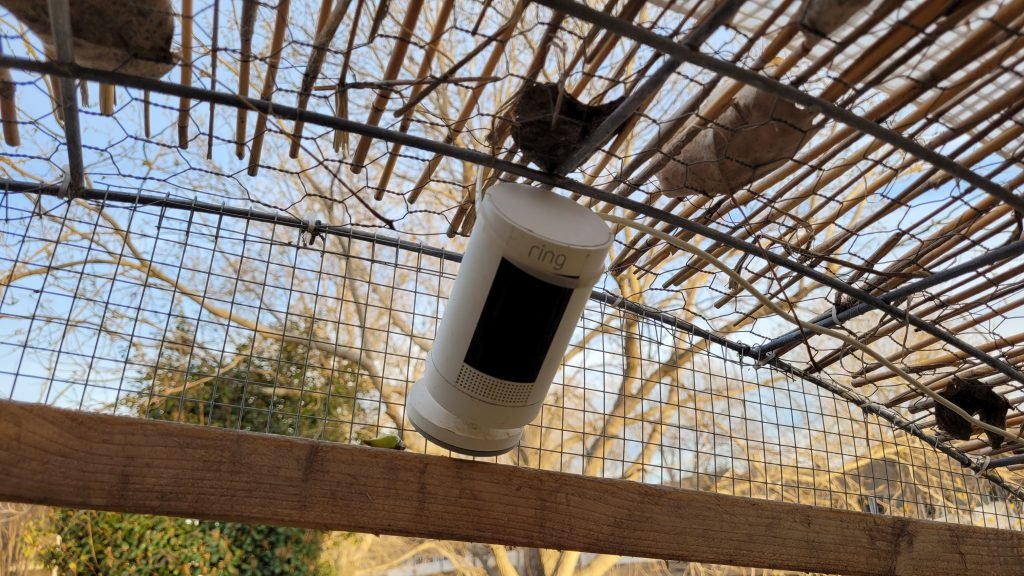
It is good to have peace of mind. Even when I am not home, I can see what’s going on quickly. We use ring cameras with solar panels and are very happy with them. The one in the backyard also has a flashlight and a siren that deters bigger predators like bobcats or coyotes.
Lighting
We have some string lights inside the run. This looks cute and is a good light source for us when we go in to lock up the ducks for the night. Our light also works with a solar panel, so no extension cords are needed. For dark and rainy days, we have some battery-charged LED lights as emergency lights.
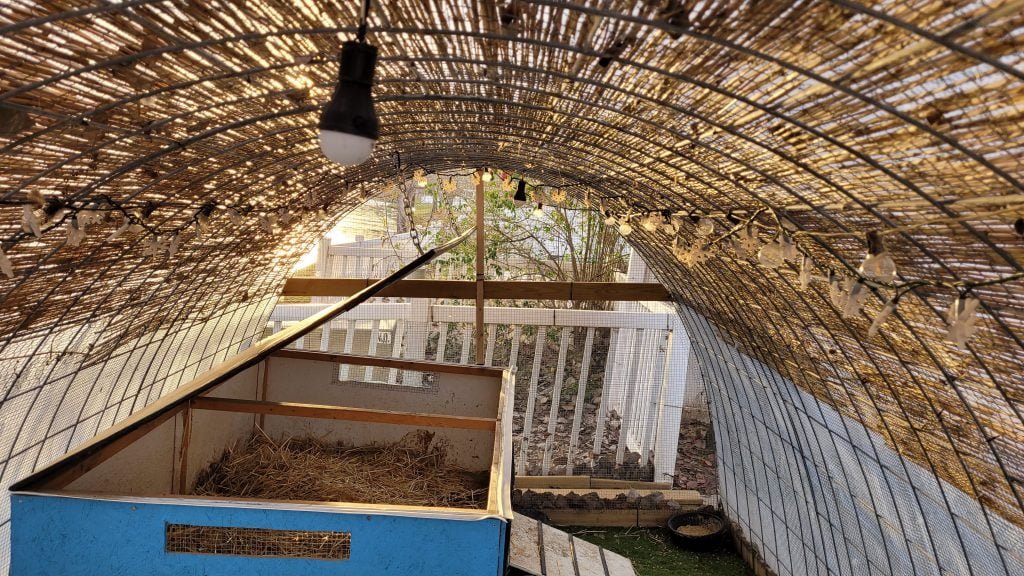
Electric Fences
Depending on where you live, you may want to consider electric fencing, especially if you have bigger predators, such as bears or wolves. They could otherwise quickly destroy your run.
What Else?
There are some other things to consider when building your duck coop and run. Automatic coop doors, for example. Or make your duck’s home cozy and optically appealing.
We have also compiled a list of useful items for duck coops and runs in our Amazon Idea List.


